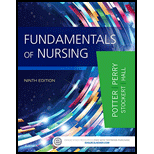
Fundamentals of Nursing, 9e
9th Edition
ISBN: 9780323327404
Author: Patricia A. Potter RN MSN PhD FAAN, Anne Griffin Perry RN EdD FAAN, Patricia Stockert RN BSN MS PhD, Amy Hall RN BSN MS PhD CNE
Publisher: Elsevier Science
expand_more
expand_more
format_list_bulleted
Concept explainers
Question
Chapter 30, Problem 8RQ
Summary Introduction
Tachycardia is also referred to as tachyarrhythmia. It is a condition in which the heart rate exceeds than the normal resting rate. Normal heartbeat rate is of 75 beats/minute. If the resting rate is above 100 beats per minute, this condition can be considered as tachycardia in the case of adults.
Expert Solution & Answer
Want to see the full answer?
Check out a sample textbook solution
Students have asked these similar questions
63.
64.
65.
Rhythm:
P wave:
QRS Complex:
Rate:
PRI:
Interpretation:
Rhythm:
P wave:
QRS Complex:
66.
67.
68.
Rhythm:
P wave:
QRS Complex:
Rhythm:
P wave:
QRS Complex:
Rate:
PRI:
Interpretation:
Rate:
PRI:
Interpretation:
Rate:
PRI:
Interpretation:
59.
57.
60.
62.
55.
سلسلہ
་་་་
• Define the first stage of labour.
• Describe the physiology of the first stage of labour.
• Enumerate any four (4) potential complications during puerperium and highlight key measures to manage these complications.
Chapter 30 Solutions
Fundamentals of Nursing, 9e
Knowledge Booster
Learn more about
Need a deep-dive on the concept behind this application? Look no further. Learn more about this topic, nursing and related others by exploring similar questions and additional content below.Similar questions
- • Define obstetric emergencies and state and briefly explain any two (2) maternal, foetal, and obstetric complications that require immediate intervention. • Explain how mental health services can be effectively integrated into maternal and child health, viz-a-viz early childhood development. • Enumerate any four (4) foetal malpresentations in pregnancy and briefly explain their implication in labour while also highlighting their causes and possible complications.arrow_forward• Briefly highlight the physiological changes in pregnancy in relation to cardiovascular and endocrine systems, as well as the uterus and the skin. • Discuss the current antenatal care approach for pregnant women and provide the highlight of activities conducted during woman’s antenatal visit, clearly describing the steps needed for successful antenatal care. • Enumerate any three (3) abnormalities related to placental development and their implications to pregnancy or childbirth.arrow_forward58 64. Rhythm: Clues: Rhythm: Clues: 62 Rhythm QRS Complex Rates PRI Interpretation Rhythm: P wave QRS Complex Rate PRI Interpretation Rhythm: Clues: Rhythm P wave: QRS Complex Rate PRI Interpretation: Rhythm: P wave: QRS Complex: Rate: Interpretation: 67 Rhythm: P wave: QRS Complex: Rate: PRI Interpretation: Rhythm: P wave: QRS Complex: Rate: PRI Interpretation: 68 Rhythm P waves QRS Complex Rate PRI Interpretation Rhythm P wave QRS Complex Rhythm: P wave QRS Complex: Rate PRI Interpretations Rate PRI Interpretationarrow_forward
- 51. 52. 53. Rhythm: Clues: Rhythm: Clues: Rhythm: Clues:arrow_forwardRegularity- Rate- P waves- PRI- QRS- Interpretation- atrial dysrthmia,junctional dysrthymia,and ventricular rhythm,heart blocks,normal sinus,PVCarrow_forwardnormal sinus,atrial dysrthmia,junctional dysrthymia,and ventricular rhythm,heart blocks,PVCarrow_forward
- normal sinus,atrial dysrthmia,junctional dysrthymia,and ventricular rhythm,heart blocksarrow_forwardA 40-year-old male farmer was rushed to an ER with complaints of fever, abdominal pain/tenderness, nausea and vomiting. Clinical examination and investigations revealed diagnosis of typhoid perforation and he was booked for exploratory laparotomy. Explain in detail the pre - operative care of this patient.arrow_forwardAs a nursing student wanting to do preceptorship at ICU or ER, answer the following question: Why are you requesting this site? How will this unit meet your learning needs?How will this unit contribute to your professional goals?arrow_forward
- As a nursing student wanting to do preceptorship at the cancer clinic. Answer the following question. Why are you requesting this unit? How will this site meet your learning needs? How will this unit contribute to your professional goals?arrow_forward40. Rhythm (regular or irregular):. Rate: P wave: PR interval: QRS: Interpretation:arrow_forwarddetermine ventricular rhythm stripsarrow_forward
arrow_back_ios
SEE MORE QUESTIONS
arrow_forward_ios
Recommended textbooks for you
 Phlebotomy EssentialsNursingISBN:9781451194524Author:Ruth McCall, Cathee M. Tankersley MT(ASCP)Publisher:JONES+BARTLETT PUBLISHERS, INC.
Phlebotomy EssentialsNursingISBN:9781451194524Author:Ruth McCall, Cathee M. Tankersley MT(ASCP)Publisher:JONES+BARTLETT PUBLISHERS, INC. Gould's Pathophysiology for the Health Profession...NursingISBN:9780323414425Author:Robert J Hubert BSPublisher:Saunders
Gould's Pathophysiology for the Health Profession...NursingISBN:9780323414425Author:Robert J Hubert BSPublisher:Saunders Fundamentals Of NursingNursingISBN:9781496362179Author:Taylor, Carol (carol R.), LYNN, Pamela (pamela Barbara), Bartlett, Jennifer L.Publisher:Wolters Kluwer,
Fundamentals Of NursingNursingISBN:9781496362179Author:Taylor, Carol (carol R.), LYNN, Pamela (pamela Barbara), Bartlett, Jennifer L.Publisher:Wolters Kluwer, Fundamentals of Nursing, 9eNursingISBN:9780323327404Author:Patricia A. Potter RN MSN PhD FAAN, Anne Griffin Perry RN EdD FAAN, Patricia Stockert RN BSN MS PhD, Amy Hall RN BSN MS PhD CNEPublisher:Elsevier Science
Fundamentals of Nursing, 9eNursingISBN:9780323327404Author:Patricia A. Potter RN MSN PhD FAAN, Anne Griffin Perry RN EdD FAAN, Patricia Stockert RN BSN MS PhD, Amy Hall RN BSN MS PhD CNEPublisher:Elsevier Science Study Guide for Gould's Pathophysiology for the H...NursingISBN:9780323414142Author:Hubert BS, Robert J; VanMeter PhD, Karin C.Publisher:Saunders
Study Guide for Gould's Pathophysiology for the H...NursingISBN:9780323414142Author:Hubert BS, Robert J; VanMeter PhD, Karin C.Publisher:Saunders Issues and Ethics in the Helping Professions (Min...NursingISBN:9781337406291Author:Gerald Corey, Marianne Schneider Corey, Cindy CoreyPublisher:Cengage Learning
Issues and Ethics in the Helping Professions (Min...NursingISBN:9781337406291Author:Gerald Corey, Marianne Schneider Corey, Cindy CoreyPublisher:Cengage Learning

Phlebotomy Essentials
Nursing
ISBN:9781451194524
Author:Ruth McCall, Cathee M. Tankersley MT(ASCP)
Publisher:JONES+BARTLETT PUBLISHERS, INC.

Gould's Pathophysiology for the Health Profession...
Nursing
ISBN:9780323414425
Author:Robert J Hubert BS
Publisher:Saunders

Fundamentals Of Nursing
Nursing
ISBN:9781496362179
Author:Taylor, Carol (carol R.), LYNN, Pamela (pamela Barbara), Bartlett, Jennifer L.
Publisher:Wolters Kluwer,

Fundamentals of Nursing, 9e
Nursing
ISBN:9780323327404
Author:Patricia A. Potter RN MSN PhD FAAN, Anne Griffin Perry RN EdD FAAN, Patricia Stockert RN BSN MS PhD, Amy Hall RN BSN MS PhD CNE
Publisher:Elsevier Science

Study Guide for Gould's Pathophysiology for the H...
Nursing
ISBN:9780323414142
Author:Hubert BS, Robert J; VanMeter PhD, Karin C.
Publisher:Saunders

Issues and Ethics in the Helping Professions (Min...
Nursing
ISBN:9781337406291
Author:Gerald Corey, Marianne Schneider Corey, Cindy Corey
Publisher:Cengage Learning
How stress affects your body - Sharon Horesh Bergquist; Author: TED-Ed;https://www.youtube.com/watch?v=v-t1Z5-oPtU;License: Standard Youtube License